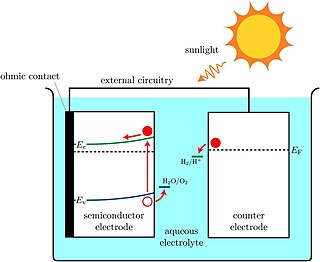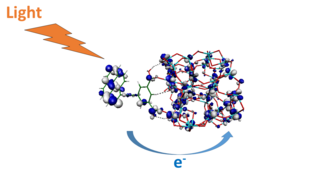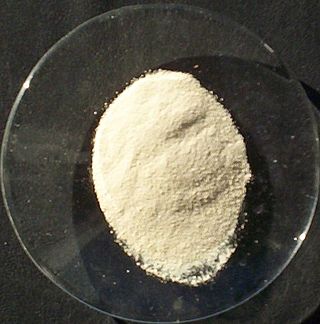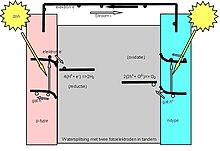
Photoelectrolysis of water, also known as photoelectrochemical water splitting, occurs in a photoelectrochemical cell when light is used as the energy source for the electrolysis of water, producing dihydrogen which can be used as a fuel. This process is one route to a "hydrogen economy", in which hydrogen fuel is produced efficiently and inexpensively from natural sources without using fossil fuels. In contrast, steam reforming usually or always uses a fossil fuel to obtain hydrogen. Photoelectrolysis is sometimes known colloquially as the hydrogen holy grail for its potential to yield a viable alternative to petroleum as a source of energy; such an energy source would supposedly come without the sociopolitically undesirable effects of extracting and using petroleum.
Artificial photosynthesis is a chemical process that biomimics the natural process of photosynthesis. The term artificial photosynthesis is used loosely, refer to any scheme for capturing and storing energy from sunlight by producing a fuel, specifically a solar fuel. An advantage of artificial photosynthesis is that the solar energy can be immediately converted and stored. By contrast, using photovoltaic cells, sunlight is converted into electricity and then converted again into chemical energy for storage, with some necessary losses of energy associated with the second conversion. The byproducts of these reactions are environmentally friendly. Artificially photosynthesized fuel would be a carbon-neutral source of energy, which could be used for transportation or homes. The economics of artificial photosynthesis are not competitive.

Water splitting is the chemical reaction in which water is broken down into oxygen and hydrogen:

In chemistry, photocatalysis is the acceleration of a photoreaction in the presence of a photocatalyst, the excited state of which "repeatedly interacts with the reaction partners forming reaction intermediates and regenerates itself after each cycle of such interactions." In many cases, the catalyst is a solid that upon irradiation with UV- or visible light generates electron–hole pairs that generate free radicals. Photocatalysts belong to three main groups; heterogeneous, homogeneous, and plasmonic antenna-reactor catalysts. The use of each catalysts depends on the preferred application and required catalysis reaction.

A dye-sensitized solar cell is a low-cost solar cell belonging to the group of thin film solar cells. It is based on a semiconductor formed between a photo-sensitized anode and an electrolyte, a photoelectrochemical system. The modern version of a dye solar cell, also known as the Grätzel cell, was originally co-invented in 1988 by Brian O'Regan and Michael Grätzel at UC Berkeley and this work was later developed by the aforementioned scientists at the École Polytechnique Fédérale de Lausanne (EPFL) until the publication of the first high efficiency DSSC in 1991. Michael Grätzel has been awarded the 2010 Millennium Technology Prize for this invention.

A solid oxide electrolyzer cell (SOEC) is a solid oxide fuel cell that runs in regenerative mode to achieve the electrolysis of water by using a solid oxide, or ceramic, electrolyte to produce hydrogen gas and oxygen. The production of pure hydrogen is compelling because it is a clean fuel that can be stored, making it a potential alternative to batteries, methane, and other energy sources. Electrolysis is currently the most promising method of hydrogen production from water due to high efficiency of conversion and relatively low required energy input when compared to thermochemical and photocatalytic methods.
Photocatalytic water splitting is a process that uses photocatalysis for the dissociation of water (H2O) into hydrogen (H
2) and oxygen (O
2). The inputs are light energy (photons), water, and a catalyst(s). The process is inspired by Photosynthesis, which converts water and carbon dioxide into oxygen and carbohydrates. Water splitting using solar radiation has not been commercialized. Photocatalytic water splitting is done by dispersing photocatalyst particles in water or depositing them on a substrate, unlike Photoelectrochemical cell, which are assembled into a cell with a photoelectrode. Hydrogen fuel production using water and light (photocatalytic water splitting), instead of petroleum, is an important renewable energy strategy.
Photoelectrochemistry is a subfield of study within physical chemistry concerned with the interaction of light with electrochemical systems. It is an active domain of investigation. One of the pioneers of this field of electrochemistry was the German electrochemist Heinz Gerischer. The interest in this domain is high in the context of development of renewable energy conversion and storage technology.
Photoelectrochemical reduction of carbon dioxide, also known as photoelectrolysis of carbon dioxide, is a chemical process whereby carbon dioxide is reduced to carbon monoxide or hydrocarbons by the energy of incident light. This process requires catalysts, most of which are semiconducting materials. The feasibility of this chemical reaction was first theorised by Giacomo Luigi Ciamician, an Italian photochemist. Already in 1912 he stated that "[b]y using suitable catalyzers, it should be possible to transform the mixture of water and carbon dioxide into oxygen and methane, or to cause other endo-energetic processes."
Water oxidation is one of the half reactions of water splitting:
Solar–hydrogen energy cycle is an energy cycle where a solar powered electrolyzer is used to convert water to hydrogen and oxygen. Hydrogen and oxygen produced thus are stored to be used by a fuel cell to produce electricity when no sunlight is available.
A solar fuel is a synthetic chemical fuel produced from solar energy. Solar fuels can be produced through photochemical, photobiological, and electrochemical reactions.

Bismuth vanadate is the inorganic compound with the formula BiVO4. It is a bright yellow solid. It is widely studied as visible light photo-catalyst with a narrow band gap of less than 2.4 eV. It is a representative of "complex inorganic colored pigments," or CICPs. More specifically, bismuth vanadate is a mixed-metal oxide. Bismuth vanadate is also known under the Colour Index International as C.I. Pigment Yellow 184. It occurs naturally as the rare minerals pucherite, clinobisvanite, and dreyerite.
Biological photovoltaics, also called biophotovoltaics or BPV, is an energy-generating technology which uses oxygenic photoautotrophic organisms, or fractions thereof, to harvest light energy and produce electrical power. Biological photovoltaic devices are a type of biological electrochemical system, or microbial fuel cell, and are sometimes also called photo-microbial fuel cells or “living solar cells”. In a biological photovoltaic system, electrons generated by photolysis of water are transferred to an anode. A relatively high-potential reaction takes place at the cathode, and the resulting potential difference drives current through an external circuit to do useful work. It is hoped that using a living organism as the light harvesting material, will make biological photovoltaics a cost-effective alternative to synthetic light-energy-transduction technologies such as silicon-based photovoltaics.

Photogeochemistry merges photochemistry and geochemistry into the study of light-induced chemical reactions that occur or may occur among natural components of Earth's surface. The first comprehensive review on the subject was published in 2017 by the chemist and soil scientist Timothy A Doane, but the term photogeochemistry appeared a few years earlier as a keyword in studies that described the role of light-induced mineral transformations in shaping the biogeochemistry of Earth; this indeed describes the core of photogeochemical study, although other facets may be admitted into the definition.

Quantum photoelectrochemistry is the investigation of the quantum mechanical nature of photoelectrochemistry, the subfield of study within physical chemistry concerned with the interaction of light with electrochemical systems, typically through the application of quantum chemical calculations. Quantum photoelectrochemistry provides an expansion of quantum electrochemistry to processes involving also the interaction with light (photons). It therefore also includes essential elements of photochemistry. Key aspects of quantum photoelectrochemistry are calculations of optical excitations, photoinduced electron and energy transfer processes, excited state evolution, as well as interfacial charge separation and charge transport in nanoscale energy conversion systems.

Mixed conductors, also known as mixed ion-electron conductors(MIEC), are a single-phase material that has significant conduction ionically and electronically. Due to the mixed conduction, a formally neutral species can transport in a solid and therefore mass storage and redistribution are enabled. Mixed conductors are well known in conjugation with high-temperature superconductivity and are able to capacitate rapid solid-state reactions.

Shannon W. Boettcher is an American chemist and professor. He teaches in the Department of Chemistry and Biochemistry at the University of Oregon. His research is at the intersection of materials science and electrochemistry, with a focus on fundamental aspects of energy conversion and storage. He has been named a DuPont Young Professor, a Cottrell Scholar, a Sloan Fellow, and a Camille Dreyfus Teacher-Scholar. An ISI highly cited researcher, in 2019 he founded the Oregon Center for Electrochemistry and, in 2020, launched the nation's first targeted graduate program in electrochemical technology. In 2021, he was named a Blavatnik National Award Finalist.
Krishnan Rajeshwar is a chemist, researcher and academic. He is a Distinguished University Professor and Founding Director of the Center for Renewable Energy Science & Technology at The University of Texas at Arlington.
Solar reforming is the sunlight-driven conversion of diverse carbon waste resources into sustainable fuels and value-added chemicals. It encompasses a set of technologies operating under ambient and aqueous conditions, utilizing solar spectrum to generate maximum value. Solar reforming offers an attractive and unifying solution to address the contemporary challenges of climate change and environmental pollution by creating a sustainable circular network of waste upcycling, clean fuel generation and the consequent mitigation of greenhouse emissions.















